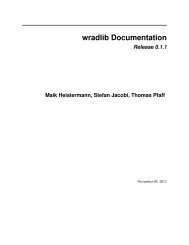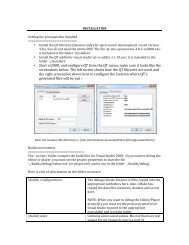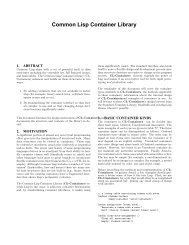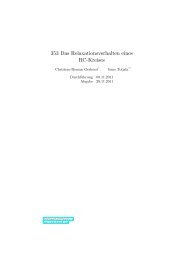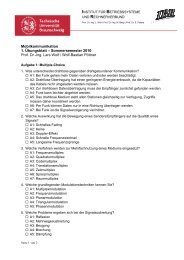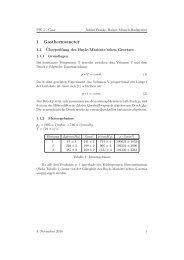P-Technique Demonstrated in Determining ... - Bitbucket
P-Technique Demonstrated in Determining ... - Bitbucket
P-Technique Demonstrated in Determining ... - Bitbucket
Create successful ePaper yourself
Turn your PDF publications into a flip-book with our unique Google optimized e-Paper software.
RAYMOND B. CATTELL, A. K. S. CATTELL, AND R. M. RHYMER 269<br />
S<strong>in</strong>ce the first theoretical presentation (4) and discussion (5, 7)<br />
of P-technique there has been no experiment which could be taken as<br />
an illustration of its work<strong>in</strong>g except possibly that of Baldw<strong>in</strong> (2)<br />
which was apparently conceived <strong>in</strong> a different theoretical framework.<br />
Prior to factor analysis (or without its employment) there have, however,<br />
been quite a number of experiments collect<strong>in</strong>g measurements on<br />
various functions on a s<strong>in</strong>gle <strong>in</strong>dividual from day to day, notably that<br />
of Dodge (12). It is possible that some of the data reported <strong>in</strong> these<br />
studies could be analyzed <strong>in</strong> the present more complex frame of reference<br />
to answer the newer questions propounded above. Baldw<strong>in</strong>'s<br />
data do not immediately throw light on these questions because of the<br />
differences between his approach and that required by P-technique.<br />
In the first place his variables have not been chosen to constitute a<br />
complete sampl<strong>in</strong>g of the personality sphere, such as might encompass<br />
the pr<strong>in</strong>cipal personality factors found by R-technique, and, <strong>in</strong> the second<br />
place, his factors are not f<strong>in</strong>ally rotated, regardless of orthogonality,<br />
for simple structure. These methodological differences, <strong>in</strong> a<br />
study excellent with<strong>in</strong> its own framework, prevent any fruitful comparisons<br />
of our results or any attempt to obta<strong>in</strong> confirmation from his<br />
results of the well-known C, E, and F personality factors (to which<br />
his f<strong>in</strong>d<strong>in</strong>gs have some fa<strong>in</strong>t resemblance) found <strong>in</strong> R-technique.*<br />
Some theoretical considerations of a narrowly statistical nature<br />
rema<strong>in</strong> to be considered <strong>in</strong> develop<strong>in</strong>g this new method, but it would<br />
be <strong>in</strong>appropriate to debate these <strong>in</strong> any detail until the basic questions<br />
have been answered. The latter concern whether the correlations obta<strong>in</strong>ed<br />
<strong>in</strong> this way transcend chance error, whether they yield factors<br />
hav<strong>in</strong>g psychological mean<strong>in</strong>g and <strong>in</strong>terest, and whether the factors<br />
are of the same general nature as the R-technique personality factors.<br />
Some statistical conditions scarcely need discussion; for example, <strong>in</strong><br />
us<strong>in</strong>g the product-moment formula the measurements must have the<br />
same closeness to a normal distribution as is reqmred for R-technique.<br />
The pr<strong>in</strong>cipal new problem concerns whether systematic trends<br />
<strong>in</strong> the measurements as they are made from day to day--trends runn<strong>in</strong>g<br />
<strong>in</strong> one direction from beg<strong>in</strong>n<strong>in</strong>g to end, such as might be associated<br />
with learn<strong>in</strong>g, maturation, or seasonal effect--should first be<br />
partialled out as "extraneous" to personality study. At least <strong>in</strong> an<br />
<strong>in</strong>itial study of this k<strong>in</strong>d the writer is quite opposed to partiall<strong>in</strong>g out<br />
* It is perhaps of historical <strong>in</strong>terest that Baldw<strong>in</strong> appears not to have viewed<br />
his experiment as an example of P-technique, cognate with the R- and Q-techniques.<br />
He regards his procedure, mistakenly <strong>in</strong> the writer's op<strong>in</strong>ion, as a statistical<br />
derivative of an earlier approach study<strong>in</strong>g frequency of association of responses<br />
<strong>in</strong> a s<strong>in</strong>gle <strong>in</strong>dividual (1). His contribution to personality study <strong>in</strong> the<br />
latter is a completely novel method, sui ,aeneris. To conceive correlation with<strong>in</strong><br />
the s<strong>in</strong>gle <strong>in</strong>dividual <strong>in</strong> this frame of reference is to miss the wider scope and<br />
flexibility of P-technique.





